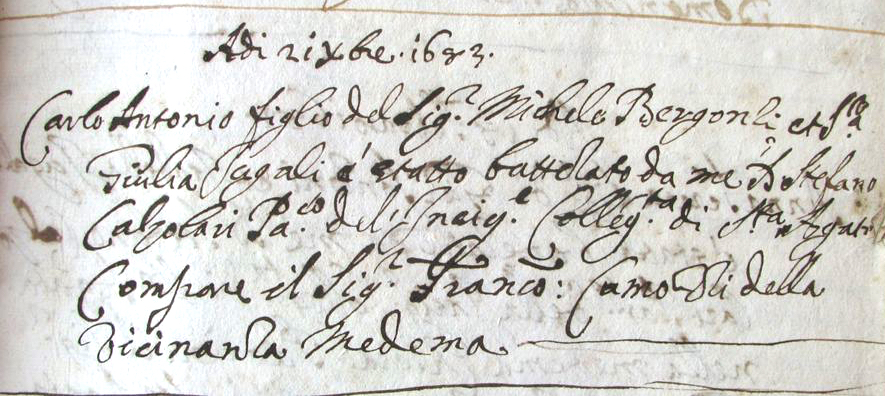There have been many speculations and assumptions made about Carlo Bergonzi (1683–1747) and his contribution to Cremonese violin making. While there is no doubt that he was a great and meticulous craftsman in the tradition of Amati and Stradivari, as well as an individual and stylish artist, his status and occupation in Cremona is far from clear. There is a common view of the typical Bergonzi model, with narrow center bouts, big, open-cut Stradivarian soundholes set low and wide, and a distinctive slender scroll with widely projecting eyes. Players hold them in similar regard to the instruments of Stradivari and ‘del Gesù’, often asserting that their characteristic response lies somewhere between the two.

The record of Carlo Bergonzi’s baptism in the Parish of Sant’Agata. Photo courtesy Carlo Chiesa and Duane Rosengard
And yet in all the collected published works barely more than 50 of his instruments are recorded, and there are possibly as few as ten surviving reliable labels. In historical accounts we read musings about an apprenticeship with Stradivari or Guarneri ‘filius Andreae’, and a life that encompassed both the great golden age of Cremonese lutherie and its apparently catastrophic decline. How can we assess a craftsman on such a small amount of verifiable work, which amounts to around two instruments for each year of his working life, and begin to discriminate between periods of development and maturity?
In 2010 the revelatory exhibition of Bergonzi’s work held in Cremona, curated by Christopher Reuning, provided a vivid new understanding of this enigmatic maker, assembling a good half of his known work. Underpinning this was startling new information, brought to light thanks to the research of Carlo Chiesa and Duane Rosengard, [1] which has led to a reassessment of Bergonzi’s entire life. The period of his creativity began in about 1716 according to the earliest account of him, given by Count Cozio di Salabue in 1816. [2] Like most commentators since then, Cozio assumed Bergonzi to have been a pupil of Stradivari. However, the new hypothesis, soundly based on observation and the archival research of Chiesa and Rosengard, is that Bergonzi’s first teacher was in fact Vincenzo Rugeri.
Vincenzo Rugeri’s workshop was close to the Bergonzi family home, and would have been the obvious source of employment for the young Carlo
The Rugeris are as mysterious in their way as Bergonzi himself. The long-standing assumption in their case that Vincenzo’s father, Francesco Rugeri, was a pupil of Nicolò Amati has also been thrown into doubt, and a closer relationship between Francesco Rugeri and Antonio Stradivari seems more than likely. Francesco was a prolific maker, steeped in the style of Amati, although exhibiting small but significant technical departures from Amatese methods and working outside of the city of Cremona in the northern parish of San Bernardo. Vincenzo was the youngest of his sons and the last active member of the family after the death of Francesco in 1698 and his brother Giovanni Battista in 1711. The Rugeri style developed considerably in his hands.
A pleasing chronology identified by Chiesa shows that Vincenzo Rugeri’s workshop, established independently from his father in the 1690s, was close to the Bergonzi family home, and would have been the obvious source of employment for the young Carlo, who reached the usual age for apprenticeship in about 1696. Furthermore, Rosengard has discovered close personal and financial connections between the two families.
